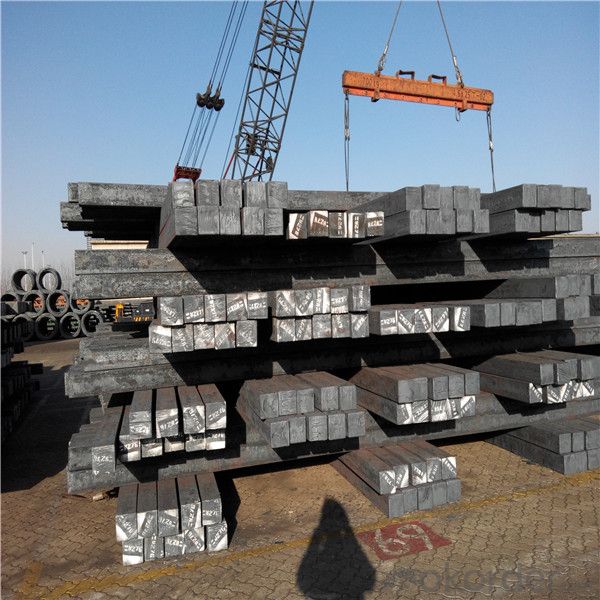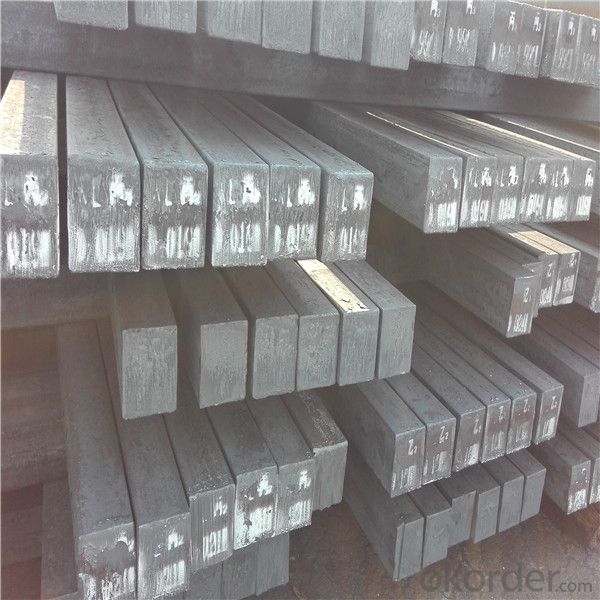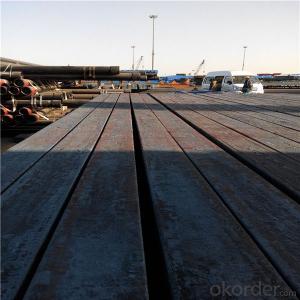Steel billet from China for sale in good quality
- Loading Port:
- Tianjin
- Payment Terms:
- TT OR LC
- Min Order Qty:
- 1000 m.t.
- Supply Capability:
- 16542 m.t./month
OKorder Service Pledge
OKorder Financial Service
You Might Also Like
Item specifice
Billets, or ingots (as they sometimes referred to), are not of practical use until they have been formed
into more functional shapes and sizes. While they have already been put in the furnace, they still require
a series of shaping and molding procedures such as hot and cold working, milling and cutting before they
are sold in hardware stores, or used for different applications. The unformed billets, however, can be used
in striking currency such as coins and as reserves, similar to gold bars.
Gade:
Standard | C(%) | Mn(%) | S(%) | P(%) | Si(%) |
Q195 | ≤0.12 | ≤0.50 | ≤0.040 | ≤0.035 | ≤0.30 |
Q235 | ≤0.20 | ≤1.40 | ≤0.045 | ≤0.045 | ≤0.35 |
Q275 | ≤0.22 | ≤1.50 | ≤0.045 | ≤0.045 | ≤0.35 |
20MnSi | 0.17-0.25 | 1.2-1.6 | ≤ 0.050 | ≤ 0.050 | 0.40-0.80 |
3SP | 0.14-0.22 | 0.40-0.85 | ≤ 0.050 | ≤ 0.040 | 0.05-0.15 |
5SP | 0.28-0.37 | 0.50-1.00 | ≤ 0.050 | ≤ 0.040 | 0.15-0.30 |




Other Specifications
Squar Tolerance: ±4
Length Tolerance: +100mm
Romboidity/Difference Diagonals: no more than 0.7%
Camber: no more than 1.5%(%)
Twist: no more than 3 degrees per 1 meter length
Our Advantage
* Professional Personnel of Steel Trading
* Strong Steel Industry Background
* Conveniently Geographic Location
Our Commitment
* Sincere, Practical, Efficient and Developing
* High Quality Steel Production
* Competitive Price and Timely Delivery
Packing :
Within 30 days
1.Standard export package
2.In bundles with steel strips
3.As the requirements of the customers
FAQ:
Q: How to get quotation?
A: When we receive your detailed enquiry, we will set the best price based on standard,
steel grade, outer diameter, wall thickness, quantity, country.
And we will send quotation to your mailbox.
Q:How to guarantee the quality of the products?
A:We have established the international advanced quality management system,every link from raw material
to final product we have strict quality test;We resolutely put an end to unqualified products flowing into the market.
At the same time, we will provide necessary follow-up service assurance.
Q:How long can we receive the product after purchase?
A :In the purchase of product within three working days, We will arrange the factory delivery as soon as possible.
The pecific time of receiving is related to the state and position of customers.
- Q:What is the average lifespan of a steel billet in the automotive industry?
- The average lifespan of a steel billet in the automotive industry can vary depending on several factors such as the specific application, type of steel used, and maintenance practices. However, on average, steel billets in the automotive industry can last for several years to decades, especially when properly cared for and maintained.
- Q:What are the main challenges in the recycling of steel billets?
- Several challenges arise when it comes to recycling steel billets, which are semi-finished steel products. The recycling process of steel billets includes several main challenges: 1. Contamination: Throughout their usage, steel billets can become contaminated with various materials such as oil, grease, paint, or other metals. Removing these contaminants and ensuring the purity of the recycled steel can be a complex and costly process. 2. Sorting and segregation: Steel billets come in different grades and sizes, requiring them to be sorted and segregated accordingly for effective recycling. This necessitates advanced sorting technologies and manual labor to ensure that the correct billets are recycled in the appropriate manner. 3. Energy consumption: The recycling of steel billets involves melting and reprocessing the steel, which demands a significant amount of energy. This energy consumption presents a challenge as it contributes to greenhouse gas emissions and increases the overall environmental impact of the recycling process. 4. Infrastructure and logistics: The collection, transportation, and processing of steel billets necessitate a well-established infrastructure and logistics network. Insufficient facilities or transportation can impede the efficient recycling of steel billets. 5. Economic viability: The economic viability of recycling steel billets can be challenging, especially when the cost of recycling exceeds the value of the recycled material. This can discourage recycling efforts and lead to a greater reliance on primary steel production. 6. Consumer awareness and participation: It is crucial to educate consumers about the importance of recycling steel billets and encourage their participation in recycling programs. Lack of awareness and indifference towards recycling can hinder the collection of steel billets for recycling purposes. 7. International trade barriers: In certain cases, trade barriers and import/export restrictions can affect the recycling of steel billets. These barriers can limit the flow of recycled steel billets across different countries, impacting the overall recycling capacity and market dynamics. To address these challenges, a collaborative effort between industries, governments, and consumers is necessary. Investments in research and development, technological advancements, and policy support can help overcome these challenges and promote the sustainable recycling of steel billets.
- Q:How do steel billets differ from steel ingots?
- Steel billets and steel ingots differ in terms of their shape and size. Steel billets are typically long and narrow, resembling a thick bar or rod, while steel ingots are larger and have a rectangular or square shape. Additionally, steel billets are usually smaller in size compared to steel ingots. Moreover, steel billets are often produced through continuous casting, while steel ingots are typically made through the traditional method of pouring molten steel into molds.
- Q:What is the purpose of using steel billets in manufacturing?
- The aim of utilizing steel billets in the manufacturing sector is to produce a dependable and adaptable raw material for diverse industrial uses. These semi-finished goods, known as steel billets, are created through the continuous casting or hot rolling methods. These solid rectangular or square-shaped steel bars act as the foundation for manufacturing a wide array of steel products. One of the main objectives of using steel billets is to provide a reliable and high-quality material with specific mechanical properties. Steel, which is composed of iron and carbon, can be customized by adjusting the carbon content, alloying elements, and heat treatment processes. By controlling these variables during the production of steel billets, manufacturers can ensure that the resulting steel products possess desired characteristics such as strength, hardness, ductility, and resistance to corrosion. Moreover, steel billets enable manufacturers to efficiently shape and form the desired end products. They can undergo further processing using techniques like hot rolling, forging, extrusion, or machining to create different shapes, sizes, and profiles. Steel billets serve as the starting point for the production of a wide range of steel products, including bars, rods, tubes, wire, structural shapes, and even intricate components for machinery, automobiles, construction, and infrastructure projects. Additionally, the utilization of steel billets in the manufacturing sector offers numerous advantages. Steel is renowned for its outstanding strength, durability, and versatility, making it an ideal material for various applications. Steel billets provide a cost-effective option for manufacturers as they can be mass-produced and easily transformed into different forms. Furthermore, steel is highly recyclable, ensuring a sustainable and environmentally friendly manufacturing process. In conclusion, the purpose of incorporating steel billets in manufacturing is to provide a consistent and high-quality raw material that can be shaped and processed into a variety of steel products. Steel billets offer the flexibility, strength, and durability required for a wide range of industrial applications, making them an indispensable component in the manufacturing industry.
- Q:What are the different surface treatments for corrosion resistance in steel billets?
- There are several surface treatments available for corrosion resistance in steel billets, including hot-dip galvanizing, electroplating, and mechanical plating. Hot-dip galvanizing involves immersing the steel billets in molten zinc, creating a protective layer that prevents corrosion. Electroplating uses an electric current to deposit a layer of metal, such as zinc or chromium, onto the surface of the billets. Mechanical plating involves tumbling the billets with metal powder, typically zinc, in a rotating drum to create a protective coating. Each of these treatments provides varying degrees of corrosion resistance and can be chosen based on specific requirements and budget constraints.
- Q:How are steel billets used in the production of industrial furnaces?
- Steel billets are used in the production of industrial furnaces as the primary raw material for constructing the furnace structure and components. These billets are melted and molded into various shapes and sizes to create the furnace body, walls, doors, and other necessary parts. The high strength and heat resistance of steel make it ideal for withstanding the extreme temperatures and harsh conditions within the furnace, ensuring its durability and longevity.
- Q:What are the different surface finishing techniques used for steel billets?
- Steel billets commonly undergo various surface finishing techniques to enhance appearance, improve corrosion resistance, and provide a protective coating. The following are some of the techniques employed: 1. Hot Rolling: Steel billets are passed through a series of hot rollers to shape them and create a smooth surface finish. This method is commonly used for producing steel plates, sheets, or structural shapes. 2. Cold Rolling: Similar to hot rolling, this technique is performed at room temperature. It results in a smoother surface finish, increased dimensional accuracy, and improved mechanical properties of the steel billets. 3. Shot Blasting: Steel billets are bombarded with high-velocity metallic or non-metallic particles to remove scale, rust, and other contaminants from the surface. This process ensures a clean and uniform appearance. 4. Pickling: Steel billets are immersed in an acid solution to eliminate oxides, scale, and rust from the surface. This method achieves a clean and smooth surface finish, ready for further processing or coating. 5. Galvanizing: The steel billets are coated with a layer of zinc using hot-dip galvanizing, electro-galvanizing, or mechanical galvanizing methods. This coating provides excellent corrosion resistance and protects against environmental factors. 6. Painting: A layer of paint or protective coating is applied to the surface of the steel billets. This technique enhances appearance and provides protection against corrosion and weathering. 7. Passivation: A chemical process is utilized to remove free iron or iron oxides from the surface of steel billets. This improves corrosion resistance, leaving a clean and passive surface. 8. Polishing: Abrasive materials or compounds are used to smoothen the surface of steel billets. This technique achieves a high gloss or mirror-like finish, enhancing the aesthetic appeal of the steel. Each of these surface finishing techniques offers unique advantages and is selected based on the specific requirements of the steel billets, including appearance, corrosion resistance, and functionality.
- Q:How do steel billets contribute to the overall noise reduction of a structure?
- Steel billets can contribute to the overall noise reduction of a structure in several ways. Firstly, steel billets are often used in the construction of walls, floors, and ceilings, which are key components in sound insulation. The density and rigidity of steel helps to effectively block and absorb sound waves, preventing them from passing through the structure and reducing noise transmission. Additionally, steel billets can be used to create acoustic panels, which are specifically designed to enhance sound absorption and reduce reverberation within a space. These panels can be strategically placed in areas where noise is a concern, such as in conference rooms, auditoriums, or music studios. By incorporating steel billets into these panels, their acoustic properties are enhanced, resulting in improved noise reduction. Moreover, steel billets can also be utilized in the manufacturing of doors and windows. These elements are often sources of sound leakage due to their susceptibility to vibrations and poor sealing. By using steel billets in the construction of doors and windows, their strength and stability are increased, reducing the amount of sound that can pass through them. Additionally, the use of steel frames and gaskets can create a tighter seal, further minimizing noise infiltration. In summary, steel billets contribute to the overall noise reduction of a structure by providing the necessary density, rigidity, and acoustic properties to effectively block, absorb, and reduce sound transmission. Whether used in construction materials, acoustic panels, or doors and windows, steel billets play a significant role in creating a quieter and more comfortable environment.
- Q:How do steel billets contribute to the manufacturing of automotive parts?
- Steel billets are the initial form of raw material used in the manufacturing of automotive parts. They are heated and shaped into various components like engine blocks, crankshafts, and suspension parts, providing the necessary strength, durability, and precision required for automotive applications.
- Q:How do steel billets contribute to the automotive industry?
- Steel billets play a crucial role in the automotive industry by serving as the primary raw material for the production of various automotive components. These components include engine parts, transmission systems, chassis, suspension systems, and other critical components that ensure the safety, performance, and durability of vehicles. One of the key contributions of steel billets to the automotive industry is their exceptional strength and durability. Steel is renowned for its high tensile strength, which allows it to withstand extreme forces and provide structural integrity to automotive components. This strength is particularly important in areas such as the frame, where it ensures the safety of passengers in the event of a collision. Additionally, steel billets offer excellent formability and versatility, allowing manufacturers to create intricate and complex automotive parts with precision. This enables the production of components that meet the specific design requirements of different vehicle models, ensuring optimal performance and functionality. Steel billets also contribute to the automotive industry by providing cost-effectiveness. Steel is a relatively affordable material compared to alternatives such as aluminum or carbon fiber. Its widespread availability and production efficiency make it a cost-effective choice for mass production, helping to keep vehicle prices reasonable for consumers. Moreover, steel billets possess excellent heat resistance and thermal conductivity properties. This makes them ideal for use in engine components, such as pistons and cylinder heads, where they can withstand high temperatures and efficiently transfer heat. Furthermore, steel billets contribute to the sustainability of the automotive industry. Steel is a highly recyclable material, with a recycling rate of around 90%. This allows for the eco-friendly disposal and reuse of steel components, reducing the environmental impact of the automotive manufacturing process. In summary, steel billets play a vital role in the automotive industry by providing the strength, durability, formability, and cost-effectiveness necessary for the production of various automotive components. Their versatility and recyclability further contribute to the sustainability of the industry. Without steel billets, the automotive industry would struggle to produce safe, reliable, and affordable vehicles.
1. Manufacturer Overview |
|
|---|---|
| Location | |
| Year Established | |
| Annual Output Value | |
| Main Markets | |
| Company Certifications | |
2. Manufacturer Certificates |
|
|---|---|
| a) Certification Name | |
| Range | |
| Reference | |
| Validity Period | |
3. Manufacturer Capability |
|
|---|---|
| a)Trade Capacity | |
| Nearest Port | |
| Export Percentage | |
| No.of Employees in Trade Department | |
| Language Spoken: | |
| b)Factory Information | |
| Factory Size: | |
| No. of Production Lines | |
| Contract Manufacturing | |
| Product Price Range | |
Send your message to us
Steel billet from China for sale in good quality
- Loading Port:
- Tianjin
- Payment Terms:
- TT OR LC
- Min Order Qty:
- 1000 m.t.
- Supply Capability:
- 16542 m.t./month
OKorder Service Pledge
OKorder Financial Service
Similar products
New products
Hot products
Hot Searches
Related keywords





























